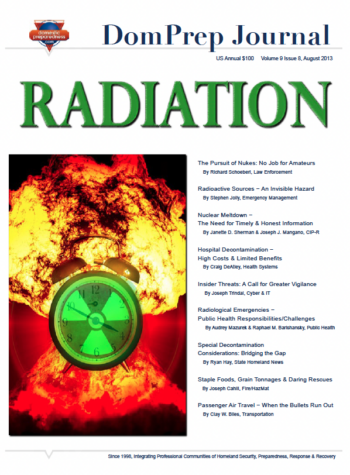
Insider Threats: A Call for Greater Vigilance
Joseph W. Trindal
August 28, 2013
When the defense for acts of insider espionage is personal conscience, at least some people show sympathy for the accused. The publicity given to such lone-actor miscreants – coupled with the growing development of and dependence on cyber capabilities – is reason enough for considerable concern in both the public and private sectors of government.

The Pursuit of Nukes: No Job for Amateurs
Richard Schoeberl
August 21, 2013
Unsecured and non-declared nuclear and radiological materials make a deadly combination, particularly attractive to terrorists. Forestalling the threat of any attack using weapons of mass destruction requires careful consideration of not only the sources of the materials used and the technological capabilities of those building such weapons but also the security at facilities where the materials may be stored.

Radioactive Sources - An Invisible Hazard
Stephen Jolly
August 21, 2013
Medical and industrial facilities, universities and colleges, cargo containers, and floodwaters have something in common with nuclear power plants – all of them can be a source of nuclear radiation. Knowing where radiation might be “hiding” within a community is the first step that emergency managers should take to protect those who are most likely to be in contact with those sources.

Radiological Emergencies - Public Health Responsibilities/Challenges
Audrey Mazurek and Raphael Barishansky
August 14, 2013
Over the past decade, U.S. public health agencies (local, state, and federal) have seen an increase of responsibility in preparing for, responding to, recovering from, and mitigating emergencies. In

Passenger Air Travel - When the Bullets Run Out
Clay W. Biles
August 14, 2013
In a passenger aircraft, there is nowhere to run when something suddenly goes wrong. Which is the primary reason that U.S. air marshals are now flying, strategically seated, on many domestic and international flights to thwart a possible terrorist threat against the aircraft and its passengers. The air marshals are armed – but their principal weapons are excellent training and continued situational awareness.

Nuclear Meltdown - The Need for Timely & Honest Information
Janette D. Sherman and Joseph J. Mangano
August 14, 2013
Similarities can be drawn between two nuclear disasters that occurred 27 years apart, in different countries. Dealing with a nuclear disaster in the United States or elsewhere still requires having accurate information – which must be delivered in time to help emergency responders deal with potentially major consequences. As long as nuclear plants exist, so does the potential threat of a meltdown.

Special Decontamination Considerations: Bridging the Gap
Ryan Hay
August 12, 2013
Following exposure to radiological or other hazardous materials, decontamination efforts often focus on the people directly involved, but other concerns also must be considered – the use of weapons and/or possible harm to animals, for example. Pennsylvania’s Lehigh County has developed a best practices approach to ensuring that response teams are prepared to cope with non-routine decontamination situations.

Transportation Security: Action Needed to Strengthen TSA's Security Threat Assessment Process
Domestic Preparedness
August 12, 2013
The U.S. Government Accountability Office was tasked to examine the performance and staffing strategy of the TSA Adjudication Center. This report addresses the extent to which: (a) TSA has measured

Hospital Decontamination - High Costs & Limited Benefits
Craig DeAtley
August 7, 2013
Article Out Loud The primary reason why the Emergency Department of almost any U.S. hospital or other healthcare facility should be ready and able to respond to a hazardous material

Staple Foods, Grain Tonnages & Daring Rescues
Joseph Cahill
August 7, 2013
It takes special equipment, and specially trained people, to rescue anyone trapped in a massive silo containing thousands of bushels of grain. Knowing what to do and how to do it – safely and successfully – could prevent fatalities caused by suffocation, toxic inhalation, or even an explosion.






